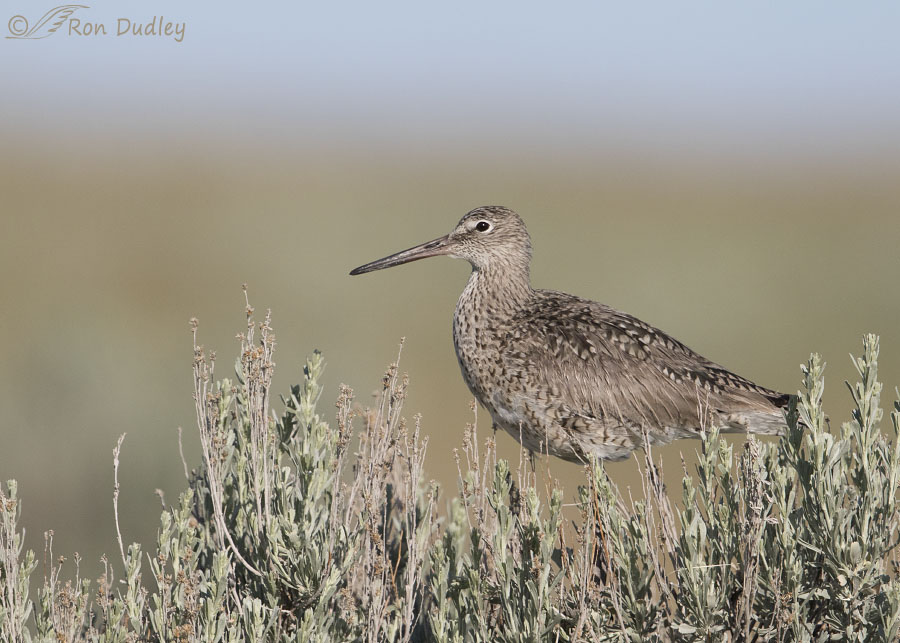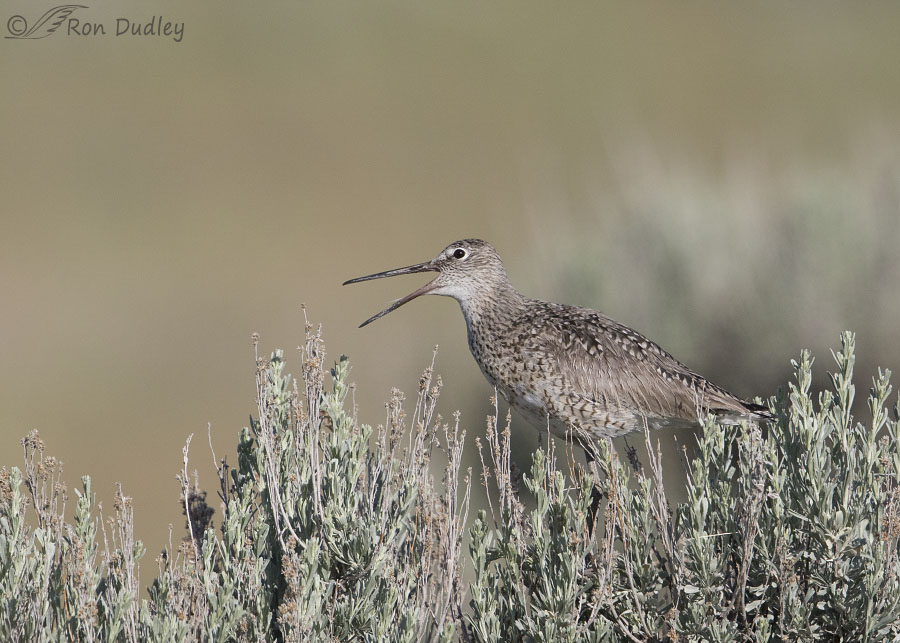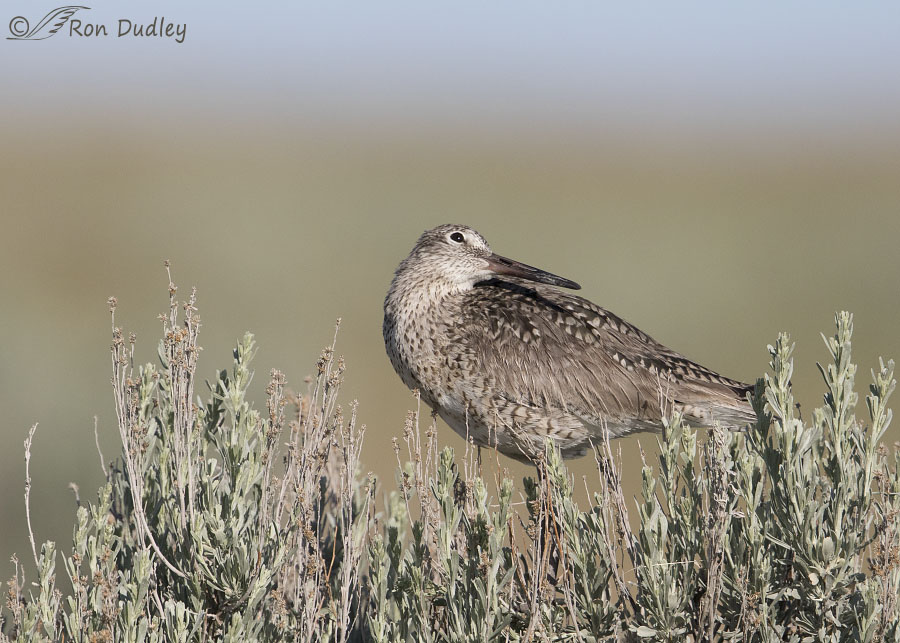Plus a bit of a behavioral mystery.
Sagebrush is so strongly associated with western deserts that it may seem incongruous for folks in wetter parts of the continent to think of it as an integral component of the habitat of shorebirds such as Willets. But in some areas of the west such as Antelope Island Willets nest on the ground in sagebrush habitats and to see them perched on top of sage is an everyday occurrence during breeding season.

1/4000, f/6.3, ISO 500, Canon 7D Mark II, Canon EF 500mm f/4L IS II USM + EF 1.4 III Extender, not baited, set up or called in
I photographed this one five days ago on the island as it was perched on sage. I wish we could see its legs but they’re often hidden by those spiky twigs and leaves. From most places on the island it’s only a short flight to the shore of the Great Salt Lake or the causeway’s edge where they can often be seen feeding in large numbers.
There’s a behavior associated with Willets perched on elevated perches like sagebrush (or large rock outcroppings) that I’ve often wondered about but have never been able to find a definite answer as to why they do it.

1/3200, f/6.3, ISO 500, Canon 7D Mark II, Canon EF 500mm f/4L IS II USM + EF 1.4 III Extender, not baited, set up or called in
During breeding season they spend inordinate amounts of time perched very conspicuously on the sagebrush or rocks, seemingly for no purpose at least at first glance. The only time I see them do anything “meaningful” while they’re perched is if another Willet flies by and then they begin calling out to each other very loudly and persistently just as this bird is doing. Sometimes I can’t see the other Willet but I can nearly always hear it calling back in response. After the second Willet has passed out of the area the calling stops.

1/4000, f/6.3, ISO 500, Canon 7D Mark II, Canon EF 500mm f/4L IS II USM + EF 1.4 III Extender, not baited, set up or called in
Moments later (after I had repositioned my pickup, thus the different background) it happened again. Here the bird is watching the overhead Willet as it passes by and this bird never took its eye off the intruder until it was gone.
When I first started seeing them do this years ago I thought it might be a courtship behavior as birds “trolled” for potential mates but now I don’t think so. Willets are monogamous and often exhibit strong mate fidelity from year to year and besides I usually see this behavior too late in the breeding season for them to be looking for mates.
Now it’s my suspicion that they’re defending nesting territories from these elevated perches and the calling out of the perched Willet is a challenge to intruders, warning them to leave the area. But that’s something I haven’t been able to confirm – even Cornell’s Birds of North America Online doesn’t describe the behavior or mention its purpose.
So for now it remains a bit of a mystery, at least to me.
Ron


I especiaLly like the first one…the pose, composition and background
What a terrific bunch of images! As usual I remember seeing Willets in Wyoming, perched on the lovely sage and what a delight. I was shocked to see them, along with an osprey family who built their nest along the Tongue River, but there they were.
I remember seeing Willets in Wyoming, perched on the lovely sage and what a delight. I was shocked to see them, along with an osprey family who built their nest along the Tongue River, but there they were.
I’ve been gone for a while because MS/Windows has been doing constant BIG updates that rearrange everything and hides some things, I know not where. That, and I’ve probably pointlessly planting plants and moderating the chat at the Cornell Redtail Hawk cam (far more productive). Oh how fast they grow! They’re standing, self-feeding and now today, one female ventured/explored out to the edge of the known world (where the sticks end) and took a nap. Seems like they were fuzzball bobbleheads just yesterday!
That said, I’ve been following, just not saying much because life keeps intervening! Like now, I need to head to town to get provisions.
Laura, My last Windows update a few days ago was huge and it caused a lot of headaches for me. It changed a lot of things it never should have messed with!
Welcome back, Laura! I’ve missed your comments!
Beautiful photos! Love all three I have a soft spot for Willets. At the Cape Cod Wildlife Sanctuary in Wellfleet Mass they perch atop the Easter White Cedars and survey all who pass by. They also fly over head and “yell” at folks who are walking on the board-walk path that cuts through the salt marshes.
“They also fly over head and “yell” at folksz’
And they can make a lot of noise, can’t they, Joanne!
Another gift.
I love your photographs and start most days ogling them.
I am super impressed at the breadth of knowledge that you and your commmentators display.
I share your boundless curiosity.
Throw frequent splashes of humour into the mix and I am sold.
Ha, without my commentators I’d be pretty dumb sometimes. Thank you, EC.
I’m one of the ones who does not expect to see Willets in the desert. I watch them all the time on the east coast. I love to watch them fly, because the seemingly drab bird becomes anything but. I like all of these shots, especially the last one. In the second one you can pretty well tell how long the legs are.
You’re right, Susan. As soon as they raise their wings they go from drab to spectacular.
I wonder if the vocalization is unique to Willets in this particular type of environment — there’s something tall to stand on, so it is doing “sentry duty.” Perhaps this behavioral adaptation is rare enough to have not made the rounds beyond the world of academia. https://www.allaboutbirds.org/guide/Willet/sounds describes the sounds and the back-and-forth, but doesn’t really say why the birds do it.
Putting my “anthropomorphizing hat” on: Maybe they’re saying something along the lines of, “Hey, watch it! I’ve got a nest here!” “Don’t worry — I’m just passing by on my way to get food for my own babies!” “That’s OK then. You may pass.” In the last shot, he sure looks like he has a Duchenne smile from a job well done.
Marty, a shorebird expert (a friend of a friend) has now weighed in on this on Facebook. Here’s what he said and I suspect he’s right:
” HI Ron, When I worked in the Great Basin we had Willet that bred in the sagebrush, sometimes surprisingly far from water. The behavior you describe sounds like part of their territory marking and vigilance behavior. Sit up in a high spot, look for potential nest predators and also tell your neighbors that this is your patch. Willets are very territorial, even on the non-breeding grounds.”
Cool! Mystery solved!
That would have been my guess Ron! But now instead of a WAG (Wild-A$$ Guess), it’s officially a SWAG (Scientific Wild A$$ Guess)! YAY!
I especiaLly like the first one…the pise, composition and background…
Thank you, Patty.
I was gifted a stage prop bird from a local opera production and wasn’t sure what kind of bird it was until I saw your picture this morning. I now know it is a Willet. It is amazing how things happen in life. I have just been to lazy to research my bird books and now I don’t have to do that. Thanks.
Ha, we just never know what good might come out of Feathered Photography, Betty. Thanks for that feedback.
Thanks for that feedback.
Something about that swath of sky makes me happy this morning. I was reading about how Goethe tried to create a scientific theory about color and emotion. I know certain colors of blue fascinate me, but in this case, I think I just like the way the blue contrasts with the sagebrush!
I like backgrounds like that too, Mary – where we can see a swath of blue sky at the top of the frame. It probably doesn’t appeal to everyone though…
Doubt it, but perhaps it’s to get an elevated perch to survey where the best feeding spots are and/or watch for predators? I also love the 2nd image, nice work once again Ron!
Thank you, Xavier.
Very nice photos Ron and educational too. I have never seen one away from water so interesting to see one in a nesting situation.
Everett Sanborn, Prescott AZ
Everett, It’s my guess that lots of folks who are familiar with Willets have never seen them in a desert environment.
Interesting! Seeing one perched on sage brush does look a little odd for sure – not where one would expect to see one Your thinking on the calling behavior from an elevated perch at the nesting time does make sense. Beautiful shots of the bird – the last one of him looking up is particularly nice………:)
Your thinking on the calling behavior from an elevated perch at the nesting time does make sense. Beautiful shots of the bird – the last one of him looking up is particularly nice………:)
Thanks, Judy. A friend of a friend (an authority on shorebirds) has been asked if he knows about the behavior. It sure would be nice to know for sure…